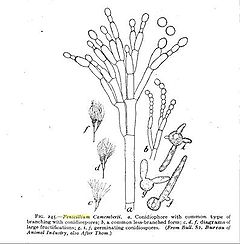Penicillium camemberti: Difference between revisions
(edited with ProveIt) |
→top: remove unsourced statement |
||
| Line 22: | Line 22: | ||
}} |
}} |
||
}} |
}} |
||
'''''Penicillium camemberti''''' is a [[species]] of [[fungus]] in the family [[Trichocomaceae]]. It is used in the production of [[Camembert (cheese)|Camembert]], [[Brie (cheese)|Brie]], [[Coulommiers cheese|Coulommiers]] and [[Cambozola]] [[cheese]]s, on which colonies of ''P. camemberti'' form a hard, white crust. It is responsible for giving these cheeses their distinctive taste. |
'''''Penicillium camemberti''''' is a [[species]] of [[fungus]] in the family [[Trichocomaceae]]. It is used in the production of [[Camembert (cheese)|Camembert]], [[Brie (cheese)|Brie]], [[Coulommiers cheese|Coulommiers]] and [[Cambozola]] [[cheese]]s, on which colonies of ''P. camemberti'' form a hard, white crust. It is responsible for giving these cheeses their distinctive taste. An allergy to Penicillin does not necessarily imply an allergy to cheeses made using ''P. camemberti''.<ref name="washingtonpost">{{cite web | url=http://www.washingtonpost.com/wp-dyn/articles/A8353-2004Aug17.html | title=Cheese Course | publisher=Washington Post | accessdate=25 July 2014 | author=Wolke, Robert L.}}</ref> |
||
When making soft cheese that involves ''Penicillium camemberti'', the mold may be mixed into the ingredients before being placed in the molds, or it may be added to the outside of the cheese after it is removed from the cheese molds.<ref>{{cite book |last=Helweg |first=Richard |title=The Complete Guide to Making Cheese, Butter, and Yogurt at Home: Everything You Need to Know Explained Simply |url=http://books.google.com/books?id=Foeo-GctrDYC&pg=PA149&dq=Penicillium+candidum&hl=en&sa=X&ei=QnoyUu3vMsmc2QWJpoEQ&ved=0CEwQ6AEwAQ#v=onepage&q=Penicillium%20candidum&f=false |accessdate=September 12, 2013 |year=2010 |publisher=Atlantic Publishing Company |isbn=9781601383556 |pages=148-149}}</ref> ''P. camemberti'' is responsible for the soft, buttery texture of brie and Camembert, but a too high concentration may lead to an undesirable bitter taste.<ref>{{cite book |last=Michelson |first=Patricia |title=Cheese: Exploring Taste and Tradition |url=http://books.google.com/books?id=oD1Z9v4mwdYC&pg=PT10&dq=Penicillium+candidum&hl=en&sa=X&ei=QnoyUu3vMsmc2QWJpoEQ&ved=0CFcQ6AEwAw#v=onepage&q=Penicillium%20candidum&f=false |accessdate=September 12, 2013 |year=2010 |publisher=Gibbs Smith |location= |isbn=9781423606512 |page=12}}</ref> |
When making soft cheese that involves ''Penicillium camemberti'', the mold may be mixed into the ingredients before being placed in the molds, or it may be added to the outside of the cheese after it is removed from the cheese molds.<ref>{{cite book |last=Helweg |first=Richard |title=The Complete Guide to Making Cheese, Butter, and Yogurt at Home: Everything You Need to Know Explained Simply |url=http://books.google.com/books?id=Foeo-GctrDYC&pg=PA149&dq=Penicillium+candidum&hl=en&sa=X&ei=QnoyUu3vMsmc2QWJpoEQ&ved=0CEwQ6AEwAQ#v=onepage&q=Penicillium%20candidum&f=false |accessdate=September 12, 2013 |year=2010 |publisher=Atlantic Publishing Company |isbn=9781601383556 |pages=148-149}}</ref> ''P. camemberti'' is responsible for the soft, buttery texture of brie and Camembert, but a too high concentration may lead to an undesirable bitter taste.<ref>{{cite book |last=Michelson |first=Patricia |title=Cheese: Exploring Taste and Tradition |url=http://books.google.com/books?id=oD1Z9v4mwdYC&pg=PT10&dq=Penicillium+candidum&hl=en&sa=X&ei=QnoyUu3vMsmc2QWJpoEQ&ved=0CFcQ6AEwAw#v=onepage&q=Penicillium%20candidum&f=false |accessdate=September 12, 2013 |year=2010 |publisher=Gibbs Smith |location= |isbn=9781423606512 |page=12}}</ref> |
||
Revision as of 03:10, 20 August 2014
| Penicillium camemberti | |
|---|---|

| |
| Scientific classification | |
| Kingdom: | |
| Division: | |
| Class: | |
| Order: | |
| Family: | |
| Genus: | |
| Species: | P. camemberti
|
| Binomial name | |
| Penicillium camemberti Thom (1906)
| |
| Synonyms[1] | |
| |
Penicillium camemberti is a species of fungus in the family Trichocomaceae. It is used in the production of Camembert, Brie, Coulommiers and Cambozola cheeses, on which colonies of P. camemberti form a hard, white crust. It is responsible for giving these cheeses their distinctive taste. An allergy to Penicillin does not necessarily imply an allergy to cheeses made using P. camemberti.[2]
When making soft cheese that involves Penicillium camemberti, the mold may be mixed into the ingredients before being placed in the molds, or it may be added to the outside of the cheese after it is removed from the cheese molds.[3] P. camemberti is responsible for the soft, buttery texture of brie and Camembert, but a too high concentration may lead to an undesirable bitter taste.[4]
References
- ^ "Penicillium camemberti Thom, U.S.D.A. Bureau of Animal Industry Bulletin, 82: 33, 1906". MycoBank. International Mycological Association. Retrieved 2013-09-12.
- ^ Wolke, Robert L. "Cheese Course". Washington Post. Retrieved 25 July 2014.
- ^ Helweg, Richard (2010). The Complete Guide to Making Cheese, Butter, and Yogurt at Home: Everything You Need to Know Explained Simply. Atlantic Publishing Company. pp. 148–149. ISBN 9781601383556. Retrieved September 12, 2013.
- ^ Michelson, Patricia (2010). Cheese: Exploring Taste and Tradition. Gibbs Smith. p. 12. ISBN 9781423606512. Retrieved September 12, 2013.
External links
